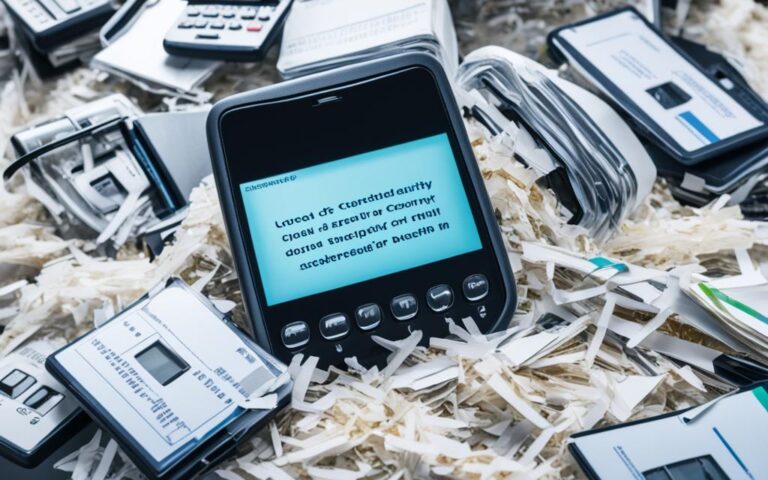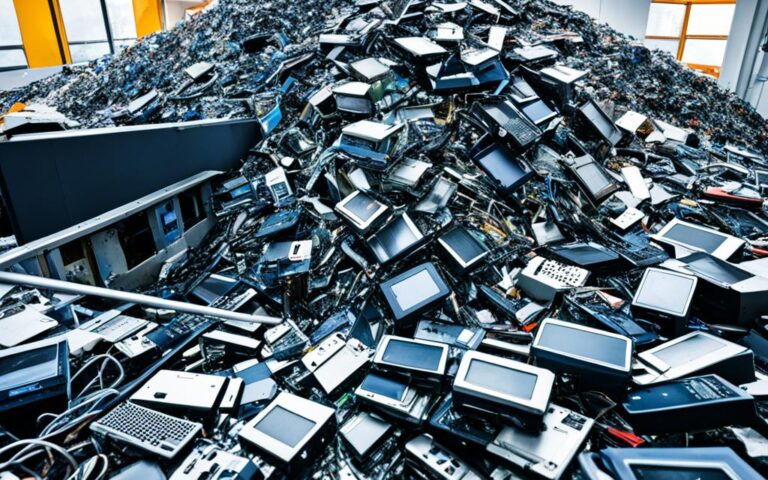The Future of E-data Destruction in Cybersecurity
In the digital age, cybersecurity is a major concern for organizations. However, a hidden threat often goes unnoticed – electronic waste or e-waste. E-waste refers to discarded electronic equipment, which can pose a significant risk if not disposed of properly. Data that hasn’t been securely removed from these devices can be exploited by malicious actors, leading to data breaches, legal liabilities, financial losses, and damage to reputation. To mitigate these risks, organizations need to adopt comprehensive IT Asset Disposition (ITAD) strategies, which involve secure data erasure and destruction, inventory and audit management, certifications and compliance, e-waste recycling, and employee training.
The Link Between E-Data Destruction and Cybersecurity
E-data destruction plays a critical role in strengthening cybersecurity measures. When organizations fail to properly destroy data from old IT assets, they run the risk of releasing sensitive information into the wild, including intellectual property, financial records, personal information, and trade secrets.
Neglecting the cybersecurity aspect of e-waste disposal can lead to severe consequences such as legal liabilities, financial losses, damage to reputation, and loss of customer trust.
It is essential for businesses to recognize the significance of implementing customized IT Asset Disposition (ITAD) solutions that address their unique needs and challenges. By doing so, they not only safeguard sensitive data but also demonstrate environmental responsibility, contributing to a sustainable digital ecosystem.
Organizations must take proactive measures to ensure the secure destruction of e-data, protecting valuable assets and preventing data breaches. Implementing robust ITAD practices that include proper data destruction methods and compliance with data protection regulations is crucial.
By prioritizing e-data destruction, businesses can avoid potential legal issues, financial impacts, and reputational damage caused by data breaches. It is not just about protecting sensitive information; it is about taking responsibility for the data we handle and the impact of our actions on the environment.
Through secure data destruction, organizations eliminate the risk of unauthorized data access, reducing potential vulnerabilities and strengthening cybersecurity defenses. Proper disposal of electronic waste is not only a cybersecurity imperative but also an environmental responsibility. By choosing sustainable disposal methods, businesses contribute to reducing electronic waste and minimizing their carbon footprint.
The Consequences of Neglecting E-Data Destruction
Neglecting e-data destruction can have dire consequences for organizations. Data breaches resulting from improper disposal of IT assets can lead to:
- Significant financial losses due to legal penalties, regulatory fines, and litigation costs
- Reputational damage, eroding customer trust and loyalty
- Loss of intellectual property and trade secrets, compromising competitive advantage
- Exposure of personal information, violating data protection regulations and privacy rights
To avoid these risks, businesses must prioritize e-data destruction as an integral part of their cybersecurity strategy. Implementing secure ITAD practices, such as data wiping, data destruction methods, and compliance with data protection regulations, is essential.
It is crucial for organizations to partner with trusted ITAD providers that adhere to recognized standards and certifications for data security and environmental responsibility. This ensures that e-waste disposal is carried out in a secure and sustainable manner.
The Importance of Environmental Responsibility
E-data destruction goes beyond cybersecurity; it is also about environmental responsibility. Electronic waste poses a significant threat to the environment if not handled properly.
By implementing secure ITAD practices and adopting sustainable disposal methods, organizations can:
- Minimize the negative impact of e-waste on the environment
- Reduce carbon emissions associated with improper disposal methods
- Promote recycling and responsible resource management
Environmental responsibility is not only a moral obligation but also a business imperative in today’s world. Customers increasingly value organizations that demonstrate their commitment to sustainability and the proper handling of electronic waste.
By embracing e-data destruction and environmental responsibility, organizations can protect sensitive information, strengthen cybersecurity, and contribute to creating a safer and more sustainable digital landscape.
The Importance of Secure Data Destruction Methods
Secure data destruction methods play a crucial role in ensuring the complete eradication of sensitive information from retired devices. It is vital for organizations to implement effective data destruction methods to eliminate any remnants of data that could be exploited by malicious actors. By employing secure data destruction practices, businesses can mitigate the risk of data breaches, legal liabilities, and damage to their reputation.
There are several methods available for secure data destruction:
- Data wiping: This method involves overwriting existing data with new information, making it impossible to recover the original data. It is a popular and cost-effective technique for securely erasing sensitive information.
- Degaussing: Degaussing utilizes strong magnetic fields to demagnetize storage devices, effectively scrambling and rendering the data unreadable. This method is commonly used for erasing data from magnetic media, such as hard drives and tapes.
- Physical destruction: Physical destruction involves physically damaging the storage device to ensure data cannot be extracted. This can be achieved through techniques like shredding or chemically treating the device. Physical destruction is often recommended for highly sensitive data and when compliance regulations require it.
Choosing the most appropriate method depends on the organization’s specific needs and compliance requirements with data protection regulations. It is essential for businesses to assess their data destruction requirements and consider factors such as data sensitivity, storage device type, and regulatory obligations.
Compliance with Data Protection Regulations
Compliance with data protection regulations is critical to protect customer information, maintain trust, and avoid legal repercussions.
Data protection regulations, such as the General Data Protection Regulation (GDPR) and the Data Protection Act, mandate the secure handling and disposal of personal and sensitive data. Organizations that fail to adhere to these regulations may face severe penalties, including fines and reputational damage.
Implementing secure data destruction methods in alignment with data protection regulations demonstrates a commitment to safeguarding customer data and complying with legal requirements. By prioritizing secure data destruction practices, organizations can maintain compliance and minimize the risk of regulatory violations.
| Data Destruction Method | Advantages | Disadvantages |
|---|---|---|
| Data wiping | – Cost-effective – Allows for reuse of storage devices |
– Time-consuming for large amounts of data – May not be suitable for certain storage media |
| Degaussing | – Effective for magnetic media – Renders data unreadable |
– Limited to magnetic media – Disposal of degaussed devices required |
| Physical destruction | – Complete destruction of data – Compliance with high-security requirements |
– Irreversible destruction – Potential environmental impact |
Note: The table above provides a comparison of different data destruction methods to help organizations make an informed decision based on their specific needs.
With the increasing importance of data protection and the growing threat of cyber attacks, organizations must prioritize secure data destruction methods. By adopting the right approach, businesses can ensure the complete eradication of sensitive information, maintain compliance with data protection regulations, and protect themselves from potential data breaches.
Best Practices for E-Waste Disposal and Data Destruction
To ensure proper e-waste disposal and data destruction, organizations should follow best practices that prioritize data security and environmental responsibility. By partnering with reputable IT Asset Disposition (ITAD) providers, organizations can effectively manage the disposal of electronic equipment while mitigating the risk of data breaches. Here are some essential practices to consider:
1. Choose Certified ITAD Providers
When selecting an ITAD provider, opt for those who adhere to recognized standards and certifications for data security and environmental responsibility. Look for certifications such as ISO 27001 for data security and Responsible Recycling (R2) for e-waste recycling. These certifications ensure that the provider follows industry best practices, ensuring proper handling and disposal of sensitive data and electronic equipment.
2. Implement Secure Data Eradication
Implement secure data wiping or destruction methods to eradicate sensitive data from retired devices. Data wiping involves overwriting the existing data on the device with random or patterned data, making the original data irrecoverable. Physical destruction methods, such as shredding or degaussing, can also be employed if necessary. By thoroughly eradicating data, organizations minimize the risk of data breaches and protect sensitive information.
3. Maintain Proper Inventory and Audit Management
Organizations should establish and maintain proper inventory and audit management systems to track the disposition of assets. This includes keeping detailed records of retired devices, their data erasure or destruction, and final disposal. Maintaining accurate records helps demonstrate compliance with regulations, facilitating risk management and regulatory audits.
4. Promote Environmental Responsibility
Environmental responsibility is a key aspect of e-waste disposal. Organizations should prioritize disposing of electronic equipment in an environmentally friendly manner. This can involve partnering with e-waste recycling facilities that adhere to proper recycling and treatment methods. By recycling electronic equipment, organizations reduce their carbon footprint and minimize the negative impact on the environment.
5. Educate and Train Employees
Employee education and training are essential to ensure employees understand the importance of ITAD and data protection during the disposal process. Training programs should cover best practices for handling e-waste, proper data destruction methods, and the significance of environmental responsibility. By empowering employees with knowledge, organizations create a culture of data security and environmental awareness.
By following these best practices for e-waste disposal and data destruction, organizations can prioritize both data security and environmental responsibility, reducing the risk of data breaches and minimizing negative environmental impact.
Conclusion
The proper disposal of e-data and electronic waste is crucial for reinforcing cybersecurity and environmental responsibility. It is imperative for businesses to recognize the risks associated with neglecting the cybersecurity aspect of e-waste, including potential data breaches and legal liabilities. By implementing comprehensive IT Asset Disposition (ITAD) strategies, organizations can protect sensitive information and uphold data protection regulations.
Comprehensive ITAD strategies should include secure data destruction, inventory and audit management, certifications and compliance, e-waste recycling, and employee training. Secure data destruction methods, such as data wiping, degaussing, and physical destruction, ensure that no remnants of sensitive information are left on retired devices. Proper inventory and audit management enable organizations to track the disposition of assets and maintain compliance with regulations.
Moreover, organizations should prioritize environmental responsibility by partnering with ITAD providers that adhere to recognized standards and certifications for both data security and environmental sustainability. By disposing of electronic equipment in an environmentally responsible manner, organizations contribute to a sustainable digital ecosystem and minimize the negative impact on the planet.
In conclusion, addressing the hidden threat of cybersecurity in e-waste is essential to maintain the integrity of data, uphold customer trust, and create a secure digital environment. By incorporating comprehensive ITAD practices and promoting environmental responsibility, organizations can ensure the proper disposal of e-data and electronic waste, protect sensitive information, and meet the challenges of the evolving cybersecurity landscape.
FAQ
What is e-waste?
E-waste refers to discarded electronic equipment.
Why is e-waste a cybersecurity concern?
E-waste can pose a significant risk if not disposed of properly, as data that hasn’t been securely removed from these devices can be exploited by malicious actors.
What is IT Asset Disposition (ITAD)?
IT Asset Disposition (ITAD) is a comprehensive strategy that involves secure data erasure and destruction, inventory and audit management, certifications and compliance, e-waste recycling, and employee training.
What are the risks of not implementing proper e-data destruction?
Neglecting the cybersecurity aspect of e-waste can lead to data breaches, legal liabilities, financial losses, damage to reputation, and loss of customer trust.
What are the methods for secure data destruction?
Data destruction methods include data wiping, degaussing, and physical destruction.
How does data wiping work?
Data wiping involves placing an additional layer of information atop existing material to cover up sensitive data.
What is degaussing?
Degaussing uses strong magnetic fields to scramble all information on a storage device.
What is physical destruction?
Physical destruction involves chemically treating or shredding the device to ensure no remnants of sensitive information are left.
How can organizations ensure proper e-waste disposal and data destruction?
Organizations should partner with ITAD providers that adhere to recognized standards and certifications for data security and environmental responsibility. They should implement secure data wiping or destruction methods and maintain inventory and audit management. Additionally, organizations should dispose of electronic equipment in an environmentally responsible manner and provide employee training on ITAD and data protection.
Why is proper e-data disposal important for cybersecurity and environmental responsibility?
Proper e-data disposal protects sensitive information, upholds data protection regulations, maintains customer trust, and contributes to a sustainable digital ecosystem.













